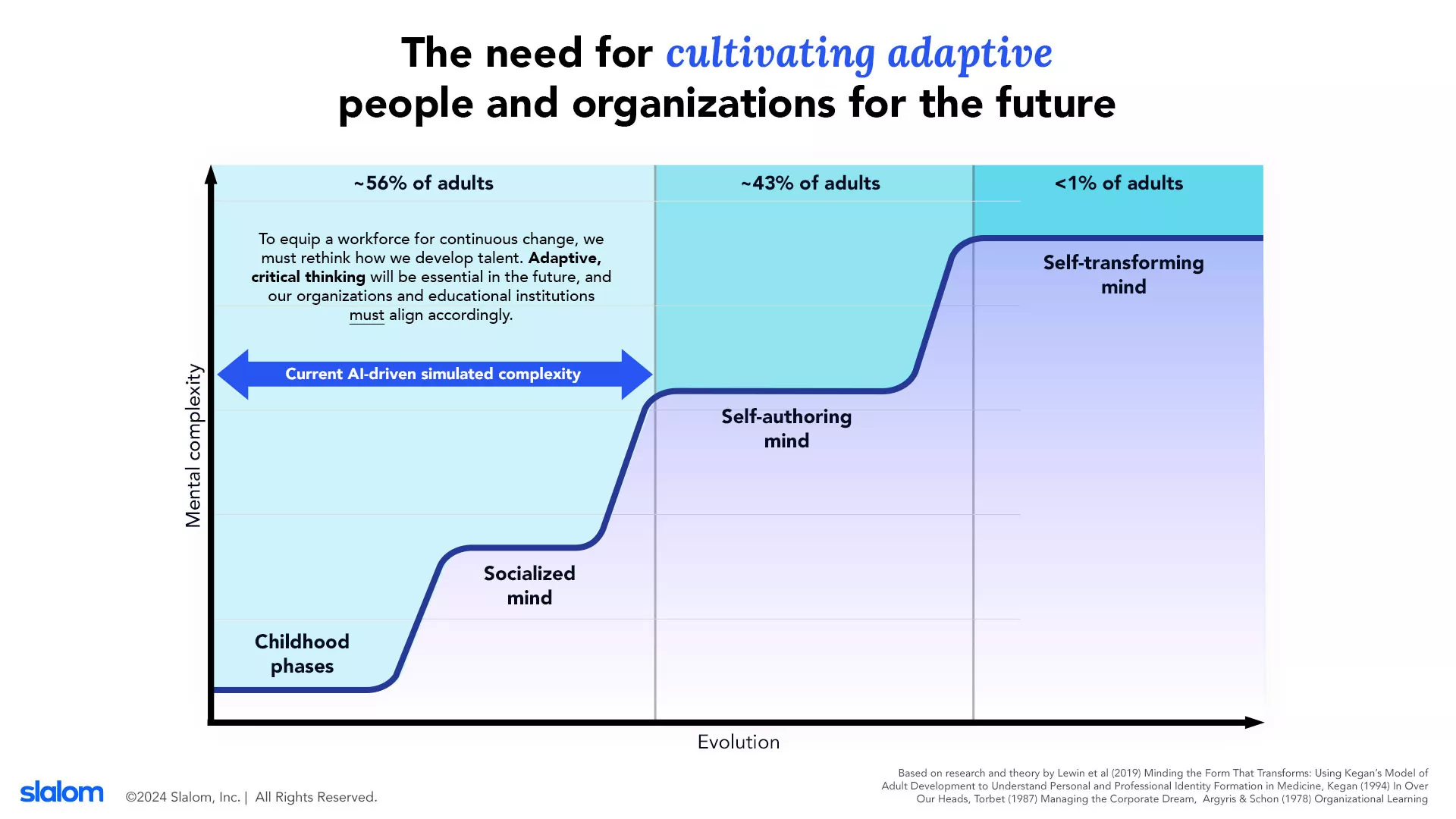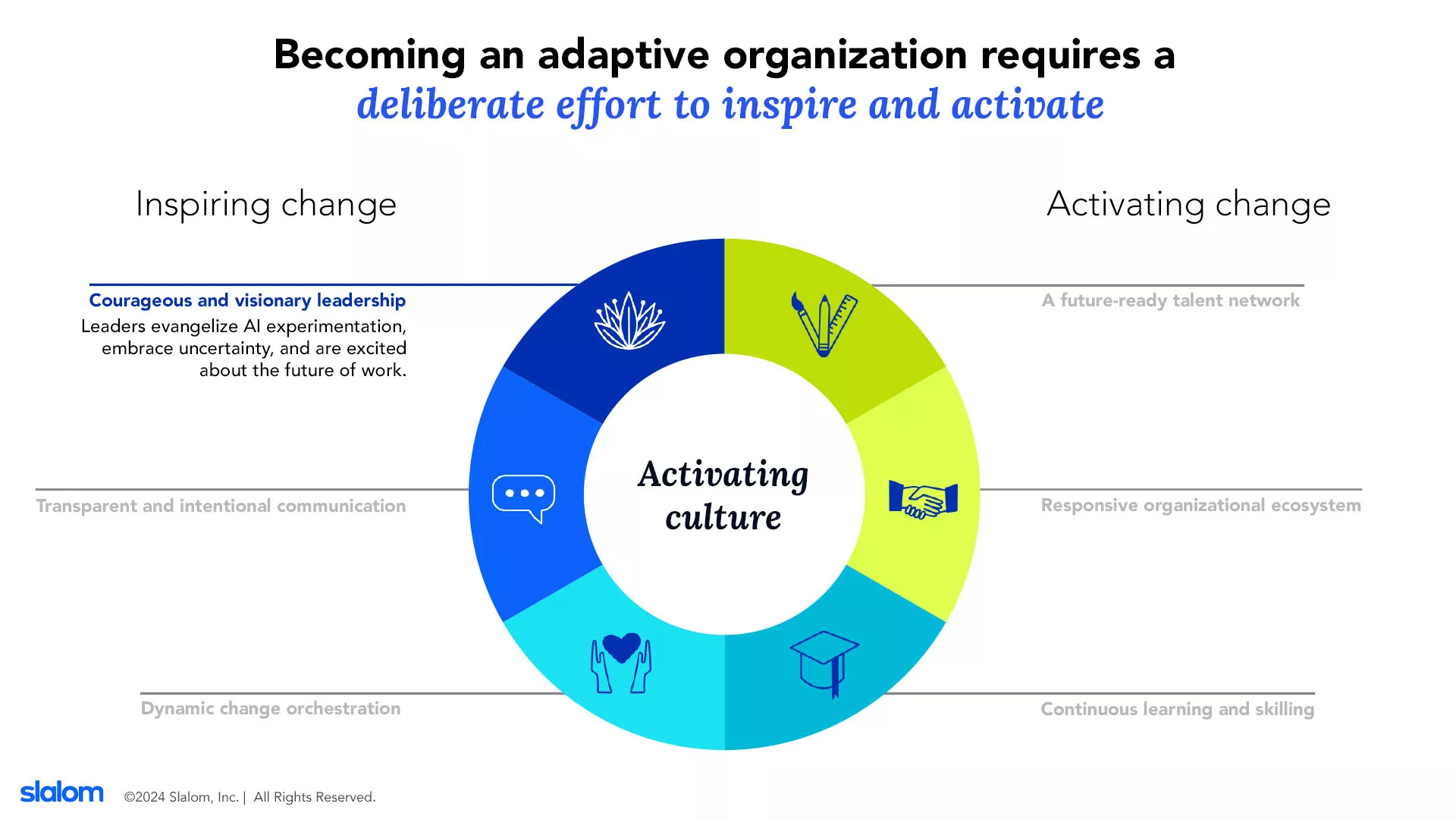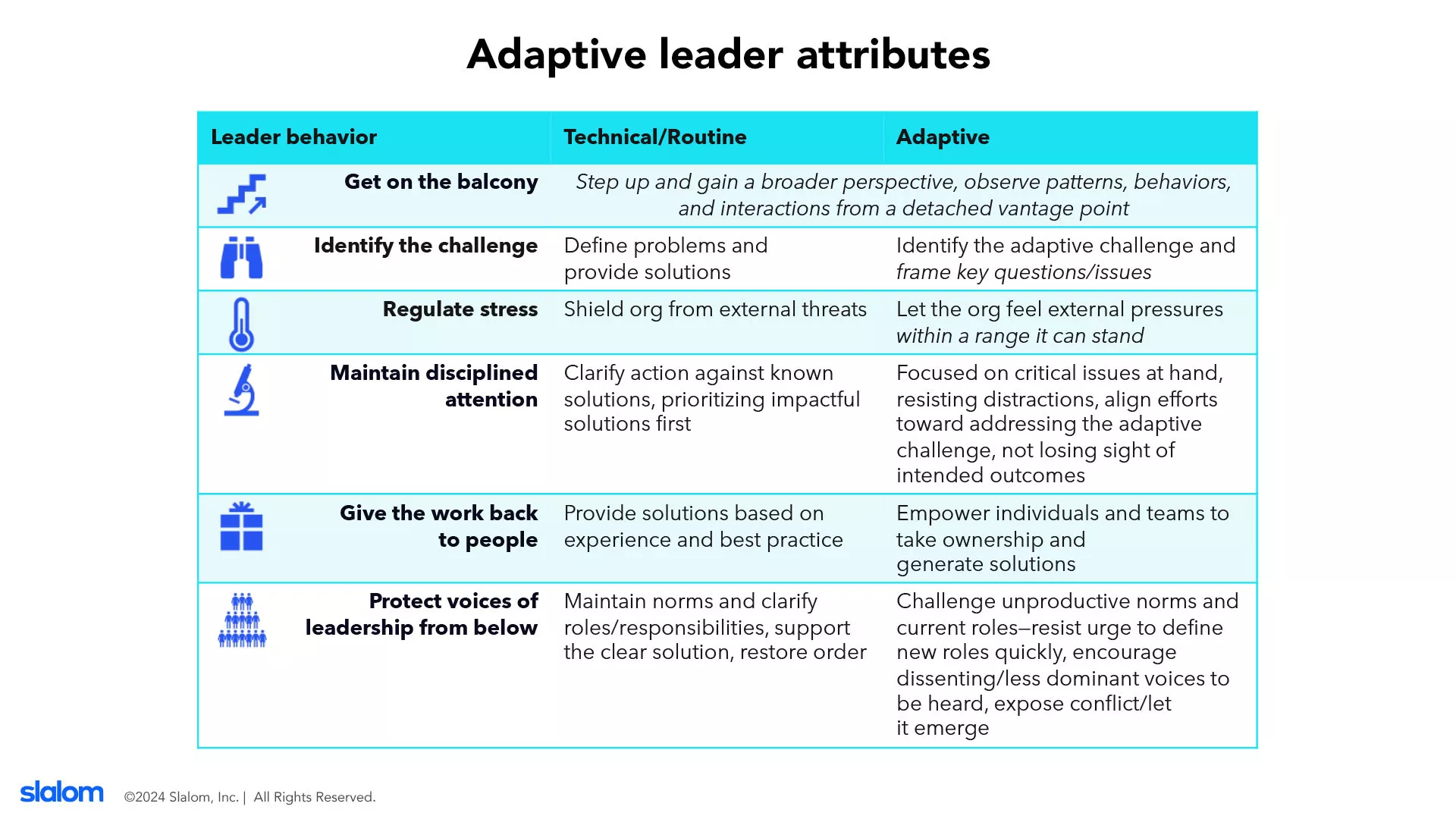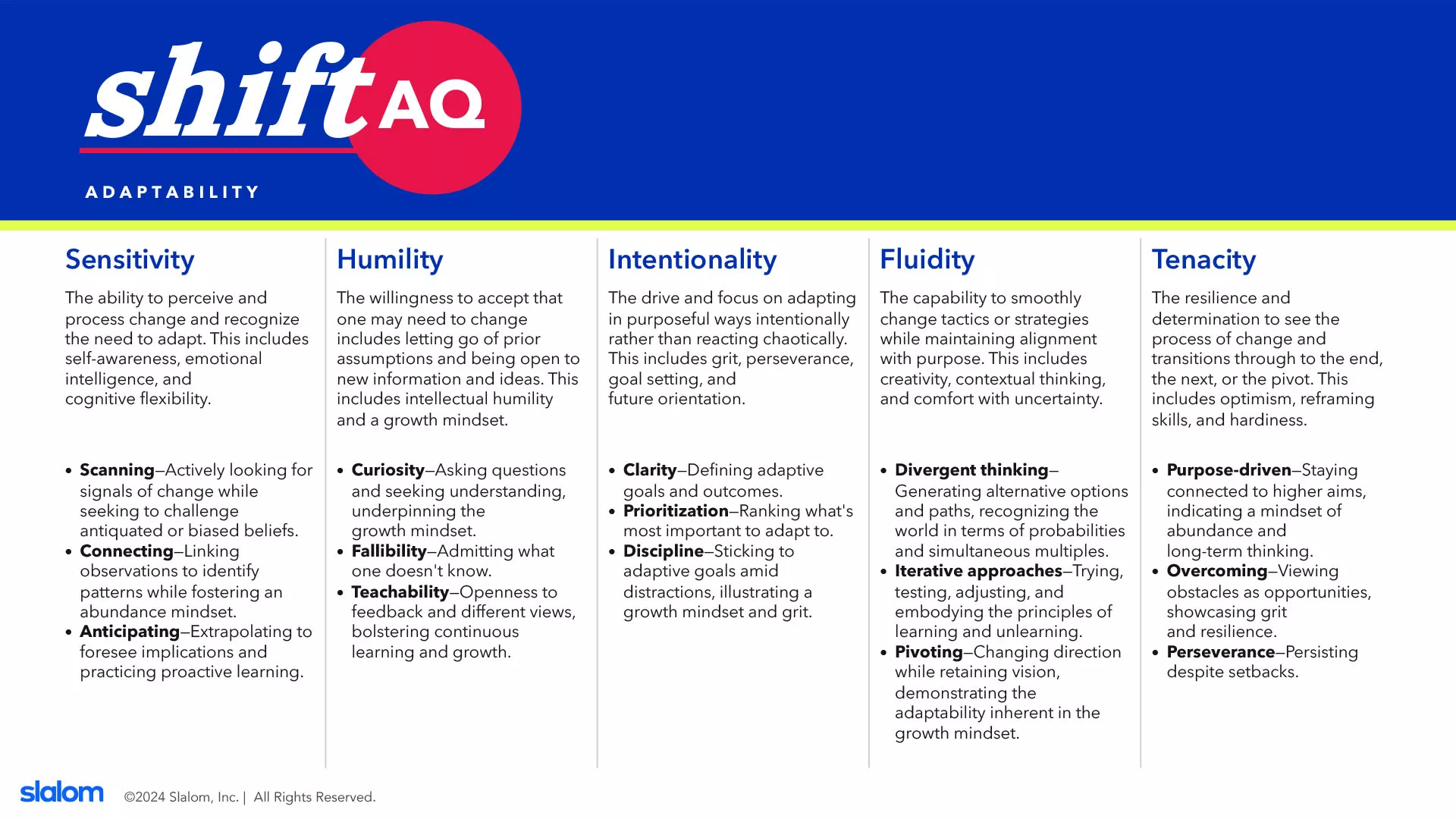The power of courageous and visionary leadership in transforming organizations

The fundamental challenge of leadership in today’s complex world is the need to recognize when problems require innovative, adaptive solutions rather than simply relying on tried-and-true methods. As the business environment grows increasingly unpredictable, leaders must develop the courage and vision to address these challenges head-on, fostering a culture of continuous learning and adaptability within their organizations.
Are your leaders prepared to transform your organization by embracing the adaptive challenges of our AI-driven era, or are they still relying on yesterday’s solutions?
According to our 2024 AI research report, 86% of executives are still leveraging traditional change management practices, underlying the need for leaders to rethink how their organizations approach the complex challenges of today.
We’re at a crucial turning point, with work evolving in the post-COVID world and new technologies rapidly transforming industries. Leaders need to quickly reassess their strategies to stay ahead of these changes. Clinging to outdated approaches or failing to act could mean falling behind in an increasingly competitive market.
“Unprecedented” and “firsts” have become the norm in recent times, leading to 71% of CEOs experiencing symptoms of impostor phenomenon and the greatest global CEO turnover in over five years. Leaders are struggling in the face of truly adaptive challenges, challenges where no one has the technical answer. Building an adaptive organization was top of mind for over 100 senior leaders we spoke to. The scenario isn’t new—Harvard professor and leadership author Ronald Heifetz stated almost two decades ago that “the single biggest failure of leadership is to treat adaptive challenges like technical problems, and therefore to apply technical solutions.” The difference, however, is that the world’s increasing complexity has accelerated and the advent of GenAI has led to new questions and fears. In physics, when the rate of change accelerates beyond our reference point, it’s known as “jerk.” But why do our brains often have trouble with the complexity of today and these more metaphorical “jerks”?
We’re glad you asked! Social and adult developmental psychology provides some answers. Approximately 56% of working adults are in what is known as a “socialized” phase of mental complexity. This means many of us regurgitate rote knowledge as truth, have limited “self-awareness” (while 95% of adults think they are self-aware, less than 15% actually are), and often try to apply common technical solutions to complex, adaptive challenges—it is no wonder that our rapidly changing business environment can feel like a significant “jerk”! The advent of AI large language models (LLMs), such as ChatGPT and Gemini, compounds this situation. LLMs are also ‘socialized’ in simulated mental complexity—they are not “self-aware,” they repeat things they were trained on as truth (mirroring real-world human biases), and as a result often solve work problems in a similar fashion to “socialized” adults. To address this challenge, we must get serious about developing “self-authoring” and transformative people unlike we have before! Adaptive thinking will be the currency of tomorrow’s human workforce, and leaders must develop themselves and their organizations to perform as such.

The role of courageous and visionary leadership
Courageous and visionary leadership involves the ability to envision the future, make bold decisions, and inspire teams to follow through with resilience and adaptability. In today’s volatile business environment, these qualities are more crucial than ever. Leaders face unprecedented challenges that demand not only technical expertise but also the ability to adapt and innovate continuously.
Visionary leaders are those who create a compelling vision that guides their organizations through complexities and uncertainties. They understand that without continuous development, both personally and within their teams, their organizations are at risk of stagnation or even decline. The ability to anticipate and adapt to change is what distinguishes successful leaders from those who are left behind.

At Slalom, we believe courageous and visionary leaders foster adaptive organizations through several key approaches, which we’ll continue to explore in depth throughout this article series.
Setting course: Crafting a compelling vision
In the face of increasing complexity and uncertainty, crafting a compelling vision is the cornerstone of effective leadership. A visionary leader must go beyond the pursuit of common ground and strive for higher ground, clearly defining the stakes and the ambitions that drive their organization forward. This involves not only articulating a powerful, magnetic vision but also embodying the continuous development (personally and organizationally) required to bring that vision to life. A vision that resonates across diverse worldviews and perspectives is critical, as it aligns various stakeholders toward a shared future. By integrating a learner and creator mindset, leaders can challenge conventional paradigms, embracing adaptability and breaking free from limiting beliefs. This approach ensures that the vision remains relevant and dynamic, is more likely to be bought into, and reduces turnover. Ultimately, leaders who rise to new levels of development and purpose, while guiding teams along the journey, can determine whether the organization thrives or falters in its pursuit of success.
Embracing adaptive change courageously: Fostering a culture of continuous growth
Embracing adaptive change requires leaders to not only set a compelling vision but also courageously embody the values and behaviors they wish to see in their organizations. This means being transparent, one-of-a-kind, and genuinely worthy of being followed; leaders inspire through their unique authenticity rather than conforming to homogenized standards. In the face of disruption, such as the rise of AI, effective leaders must embrace change without clinging to outdated identities or practices. This adaptability, rooted in a deep understanding of self and purpose, is crucial for fostering continuous growth. It’s certainly not easy work. Leaders who view themselves and their organizations as adaptive beings—constantly evolving, learning, and striving for more effective outcomes—create a culture of relentless improvement. Practical tips for modeling adaptive behaviors from author Ronald Heifetz’s framework include “getting on the balcony” to identify the technical or adaptive challenge and respond in-kind through regulating distress, maintaining disciplined attention, giving the work back to people, and protecting voices of leadership from below.

Prioritizing people: Engaging people and leading with empathy
Prioritizing people is the linchpin of any successful organization, as visionary leaders recognize that the true power of their vision depends on the collective energy, focus, and well-being of their employees. In today’s world, where the norm is often to prioritize efficiency over humanity, it’s critical to value human potential. Leaders who engage their teams with empathy, fostering real relationships and leveraging emotional intelligence (EQ), are better equipped to harness the full spectrum of their team’s capabilities. Adaptive leaders use their general intelligence (IQ), cultural intelligence (CQ), and social intelligence (SocQ) at many depths and scales simultaneously, a trait called adaptability quotient (AQ). Microsoft’s handling of GenAI is a case study in adaptive leadership—they led with vulnerability and had courage to change course swiftly, an adaptive challenge that resulted in an all-time-high market cap.
Slalom takes the concept of adaptability even further by measuring aspects of AQ across leaders, teams, and organizations. Slalom’s “SHIFT” AQ model consists of sensitivity, humility, intentionality, fluidity, and tenacity behaviors that can be assessed at all levels to help focus, evaluate, and improve adaptability. Enabling leaders to measure and enhance their organization’s AQ is critical to thrive amid technological advancements and changing environments, empower their workforce to seamlessly integrate AI, foster a culture of continuous learning, and ultimately drive stronger business outcomes.

Leadership in action
Slalom has the privilege of working with incredible leaders every day who are driving adaptive transformations in their organizations. Slalom, along with some client partners, has been at the forefront of practicing courageous and visionary leadership to develop more adaptive organizations.
We have made a multi-decade investment in our own integral leadership center of excellence (CoE) that is directly contributing to our vision of a world where you can love your work, love your life, and love your future. Our CoE is not a place that you visit like some corporate university. It’s not limited by the number of seats in a portfolio of leadership development programs.
It’s a leadership philosophy focused on upgrading mental models, reducing learning friction, and integrating deliberate practice into daily work and life. We’re building a global leadership ecosystem, involving employees, clients, and partners.
As half their executive team prepared to retire, one of the world’s most renowned architecture and design firms partnered with Slalom to launch a cutting-edge leadership development program to upskill the next generation of leaders. Co-designed with employee input, this initiative measurably shifted behaviors in 80% of their most senior leaders and sparked global enterprise changes. The program refined their operating model and introduced a dynamic new performance management philosophy, driving substantial and exciting change.
We partnered with a major life sciences organization facing cross-cultural and operational hurdles to supercharge managers as they co-created with employees on groundbreaking pilot projects to address challenges. By uncovering adaptive solutions in partnership with employees, rather than sticking to leadership's assumptions, they achieved a remarkable 11–25% boost in their lowest employee experience scores within just three months and continue to see sustainment many months later, proving the power of visionary and fearless leadership.
So where do we start?
Ignite vision with your leaders
Bring your team together to brainstorm and refine your organization's vision—ensuring it remains relevant and inspiring—and set measures and actions against it. It is amazing what some markers, Post-it Notes, and a space for conversation can do!
Launch bold pilots
Test drive new ideas for adaptive challenges on a small scale before a full-scale launch. Leaders who embrace rapid experimentation and learning can uncover breakthrough solutions with minimal risk. Explore how a small pilot can lead to significant innovations.
Transform culture through leadership
Define the adaptive culture you aspire to and craft the leadership competencies needed to drive it. Consider using SHIFT to assess AQ of your leaders, teams, and organization. Elevate your people through immersive, hands-on development programs—bespoke to your organization’s culture and aspirations. Investing in leadership development can significantly shape organizational culture. Taking a proactive approach to nurturing talent is a hallmark of visionary leadership; doing so to inspire significant culture change requires courage. As Garry Tan, CEO of the famous Y Combinator—the $3.5B incubator responsible for launching Doordash, Airbnb, and Reddit—recently explained, a lot organizations fail “not because of technical or engineering reasons, but purely people reasons” and that developing your leaders is a sound investment. So, what is your plan to develop courageous and visionary leaders?



